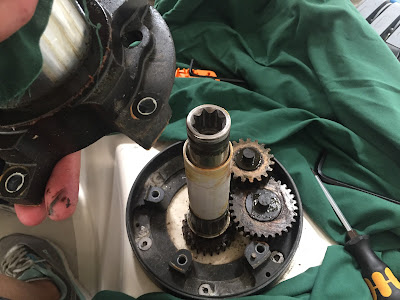With the boat in the factory, David decided to perform a 1,000 hour service on the diesel engines. As part of the service, he needed to remove the injectors. Unfortunately, after 10 years of sitting cozily in place, rust and grime had taken their toll and none of them budged. He needed an injector puller.
 |
| Official Yanmar injector puller. You don't want to know what one costs. |
Easy peasy, he thought, just order one online. After a gasp inducing quote from the local Yanmar dealer and no luck online, he collapsed defeatedly into a chair. What were we to do? Well, fabricate one of course! While that answer was obvious to all of our friends here in South Africa, it came slowly to someone spoiled by cheap Chinese imports on Amazon Prime. Thank you to Gavin at Knysna Motor Strippers for patiently explaining how to go about making our own.
Cost:
===========
2 afternoons
6 stops to local businesses
1 borrowed slide hammer
$7.50 out of pocket
The best part...it worked like a champ on the first try!
The out of pocket costs were a few nuts from the local hydraulics store and having those nuts welded together by the local welder. If David had done the welding himself it would have been cheaper (and he says much prettier)!
 |
| The lumpy thing in the middle is the adapter we made |
Unfortunately, I didn't get a photo of muscle man hammering out the injectors but, needless to say, he looked manly and handsome while doing it. The injectors came out intact and are off to get cleaned and rebuilt. The ones on the port engine were pretty dirty which could explain why that engine was running roughly. Good thing we're servicing them.
Next up: we need another tool to pull out the injector seals that didn't come out with their respective injectors. In the US, we'd call it a mechanics pick which would look something like this.
 |
| 2nd from the bottom is the one we need |
What should be a 5 minute job will probably take another 2 afternoons of running around, explaining what we need, not finding one, then convincing a machinist/welder/mechanic that our idea for making one will work well enough without an hour long design session. Good thing we're retired!











